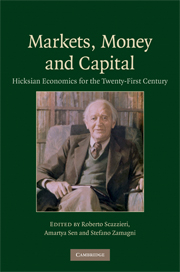Book contents
- Frontmatter
- Contents
- List of figures
- List of tables
- List of contributors
- Preface and acknowledgments
- Between theory and history: on the identity of Hicks's economics
- Part I The Intellectual Heritage of John Hicks
- Part II Markets
- 7 Hicks and the emptiness of general equilibrium theory
- 8 Hicks versus Marx? On the theory of economic history
- 9 Hicks's notion and use of the concepts of fix-price and flex-price
- 10 On the Hicksian definition of income in applied economic analysis
- Part III Money
- Part IV Capital and Dynamics
- References
- Name index
- Subject index
8 - Hicks versus Marx? On the theory of economic history
Published online by Cambridge University Press: 29 June 2009
- Frontmatter
- Contents
- List of figures
- List of tables
- List of contributors
- Preface and acknowledgments
- Between theory and history: on the identity of Hicks's economics
- Part I The Intellectual Heritage of John Hicks
- Part II Markets
- 7 Hicks and the emptiness of general equilibrium theory
- 8 Hicks versus Marx? On the theory of economic history
- 9 Hicks's notion and use of the concepts of fix-price and flex-price
- 10 On the Hicksian definition of income in applied economic analysis
- Part III Money
- Part IV Capital and Dynamics
- References
- Name index
- Subject index
Summary
On theory and history
After more than two centuries of theoretical – and, perhaps above all, empirical – analysis since Adam Smith's Wealth of Nations (1776) we have to acknowledge that we now know a great deal about the capitalist market economy, the system that has gradually taken root in more and more countries since the Industrial Revolution started in the United Kingdom.
Let us distinguish between structure and performance.
As far as structure goes, the allocation of resources and the distribution of the fruits of production are entrusted to prices and markets; production, now consisting chiefly of industry and services, is effected by powerful machinery operated by a labor force that is also bought and sold in a (special) ‘labor market’; workers are employed by firms that are owned and financed by capitalist-rentiers, run by manager-entrepreneurs, and administered internally according to principles of custom, cooperation, and command far more than on the basis of market transactions and relative prices. The mode of production and exchange that Smith and David Ricardo theorized for London and its surroundings now applies to virtually the whole world. The main difference nowadays is that workers, too, save and own assets. In the days of Smith and Ricardo they ‘subsisted’ and property was concentrated in a few hands. In an ‘average’ economy, such as Italy's, three-fourths of personal wealth and over two-thirds of personal financial assets are owned by households headed by employees or pensioners.
- Type
- Chapter
- Information
- Markets, Money and CapitalHicksian Economics for the Twenty First Century, pp. 146 - 156Publisher: Cambridge University PressPrint publication year: 2009



